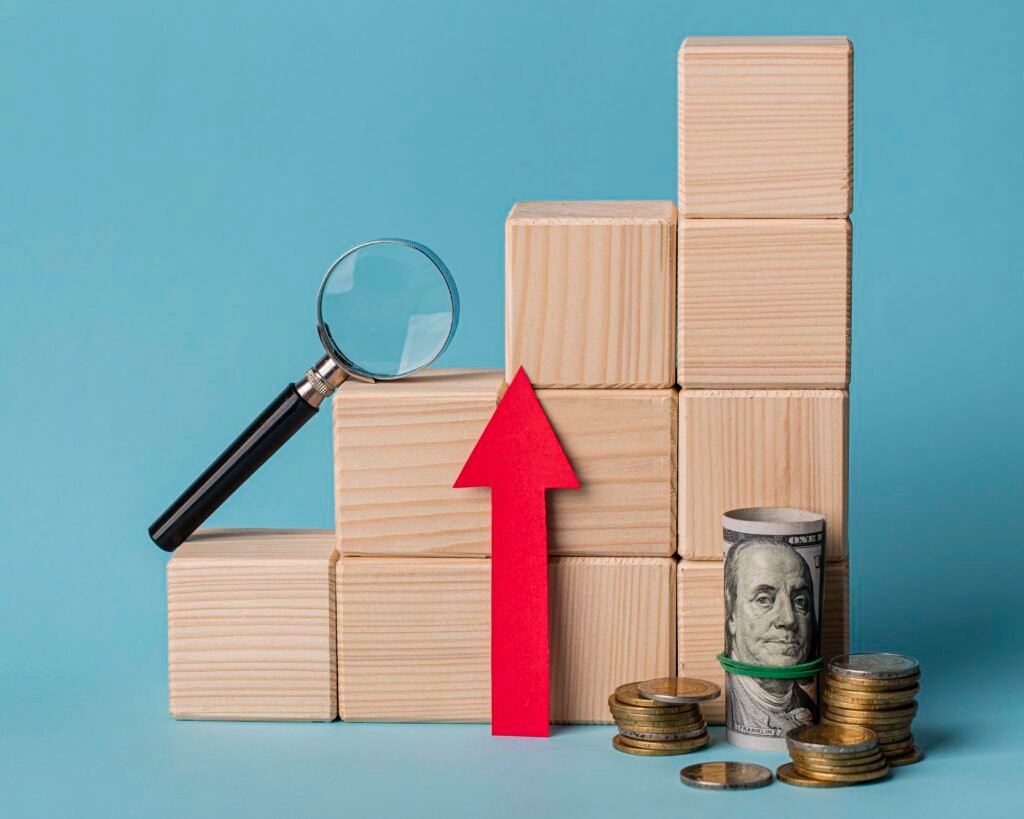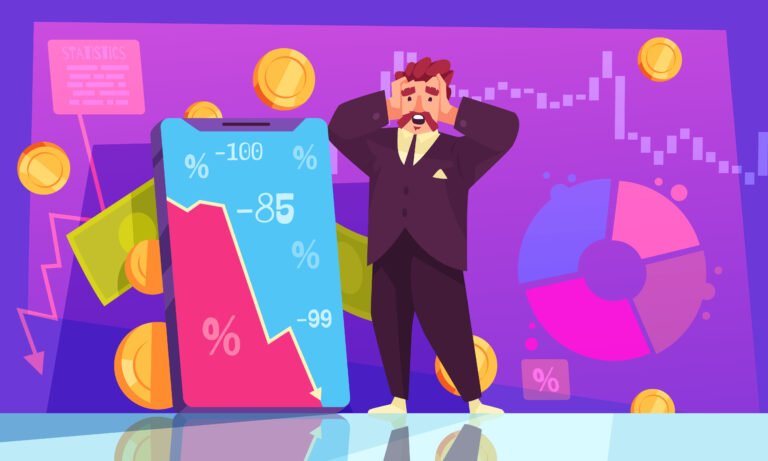1. 🧠 The Millionaire’s Secret Weapon: Compound Interest
🔹 What Is Compound Interest (In Simple Words)
Compound interest means earning interest not just on your original money (the principal)—but also on the interest you’ve already earned. It’s like earning money on your money’s money.
Example: If you invest Rs. 10,000 at 10% annual interest, you’ll earn Rs. 1,000 in year one. In year two, you earn interest on Rs. 11,000—not just your original Rs. 10,000.

🔹 Why Einstein Called It the “8th Wonder of the World”
Albert Einstein reportedly said:
“Compound interest is the 8th wonder of the world. He who understands it, earns it; he who doesn’t, pays it.”
Why? Because compounding accelerates your growth exponentially over time—doing most of the hard work for you. Millionaires use it quietly by staying invested long-term and letting their money snowball.
🔹 The Key Difference: Simple vs. Compound Interest
| Feature | Simple Interest | Compound Interest |
| Interest On | Only Principal | Principal + Accumulated Interest |
| Growth Pattern | Linear | Exponential |
| Long-Term Returns | Smaller | Much Greater |
| Real-Life Example | Bank Fixed Deposit | Long-Term Mutual Fund or Stock Investment |
In simple interest, Rs. 1 lakh may grow to Rs. 2 lakhs over 10 years. In compound interest, it could become Rs. 3+ lakhs or more, depending on the rate and compounding frequency.
2. ⏳ Time Is More Powerful Than Money
🔹 The Magic of Starting Early
In the world of compound interest, time beats everything—even the amount of money you invest.
The earlier you start, the more time your money has to grow exponentially, not just linearly.
Think of investing like planting a tree. The earlier you plant, the more years it has to grow tall and strong.
Even if you can only afford small monthly investments in your 20s, you’ll likely outperform someone who starts investing large sums in their 40s.
🔹 Real Example: $100/month Can Turn Into Over $1 Million
Let’s say you invest $100 (or ~PKR 28,000) per month, starting at age 20, with an average return of 10% annually:
- After 10 years: ~$19,000
- After 20 years: ~$68,000
- After 30 years: ~$198,000
- After 40 years: ~$638,000
- After 50 years: Over $1.17 million
💡 The total amount you invested? Only $60,000.
The rest came from compounding.
🔹 How Delaying by Just 10 Years Can Cut Your Wealth in Half
Now imagine someone starts the same $100/month investment at age 30 instead of 20.
- At age 70, they’ll have around $447,000, not $1.17 million.
👉 That 10-year delay cost them more than $700,000!
Why? Because they missed out on compounding during the early years when it matters most—the “snowball” had less time to roll and grow.
3. 💰 The Rule of 72: Doubling Your Money Made Easy
🔹 How to Use It in Everyday Investing
The Rule of 72 is a simple shortcut to estimate how long it will take to double your money with compound interest.
Just divide 72 by your annual interest rate.
Example:
At an 8% return, your money will double in:
72 ÷ 8 = 9 years
It’s not exact math—but it’s close enough for smart financial planning, especially when you’re comparing different investment options like mutual funds, stocks, or real estate.
🔹 Estimating Growth Without a Calculator
Let’s say you have Rs. 1 lakh invested at different interest rates:
| Interest Rate | Years to Double | Doubled Amount |
| 6% | 12 years | Rs. 2 lakh |
| 8% | 9 years | Rs. 2 lakh |
| 12% | 6 years | Rs. 2 lakh |
This trick lets you quickly compare returns without doing complex math or running spreadsheets.
🔹 Why 8% Matters More Than You Think
An 8% annual return may sound modest—but over time, it’s a millionaire-maker.
Let’s look at what it can do with long-term consistency:
- Rs. 10 lakh invested at 8% becomes:
- Rs. 20 lakh in ~9 years
- Rs. 40 lakh in ~18 years
- Rs. 80 lakh in ~27 years
- Over Rs. 1.6 crore in ~36 years
That’s the magic of exponential growth. With 8%, you don’t need to chase risky “get rich quick” schemes—you just need to stay invested and stay patient.
4. 📊 The Numbers Don’t Lie: Real-World Scenarios
🔹 Scenario A: Starting at 25 vs. Starting at 35
Let’s compare two friends—Ali and Zara—to see how timing changes everything.
- Ali starts investing $200/month at age 25, earns 8% per year, and stops at age 35 (just 10 years).
- Zara waits until age 35, then invests $200/month until age 65 (30 years total).
Guess who ends up with more money at age 65?
➡️ Ali does, despite investing less money overall!
| Investor | Total Invested | Years Invested | Value at 65 |
| Ali | $24,000 | 10 years | ~$314,000 |
| Zara | $72,000 | 30 years | ~$270,000 |
👉 Starting early beats investing more later. That’s the power of time and compounding.
🔹 How Small Monthly Investments Add Up Over Decades
Think Rs. 5,000/month isn’t much? Think again.
At a 10% annual return:
- After 10 years: ~Rs. 10 lakh
- After 20 years: ~Rs. 38 lakh
- After 30 years: ~Rs. 1.1 crore
💡 You don’t need to invest big—you need to invest long.
🔹 The Snowball Effect: Wealth Grows Faster Over Time
In compounding, the first few years feel slow—but the growth explodes later.
Here’s what Rs. 1 lakh invested at 10% annually looks like:
- After 10 years: ~Rs. 2.6 lakh
- After 20 years: ~Rs. 6.7 lakh
- After 30 years: ~Rs. 17.4 lakh
- After 40 years: ~Rs. 45.3 lakh
👉 The last 10 years added more than the first 30 combined.
That’s the snowball effect: the longer you roll it, the faster it grows.
5. 🔄 Reinvesting Dividends: The Turbo Boost Button
🔹 Don’t Take the Cash—Let It Compound
When your investments pay dividends (profits shared with shareholders), it’s tempting to take the cash and spend it.
But the smart move? Reinvest those dividends.
Reinvesting means using your dividend payout to buy more shares—which then earn their own dividends.
It’s compound interest on steroids.
Even a modest dividend reinvestment strategy can significantly accelerate your portfolio growth.
🔹 The Hidden Power of Dividend Growth Investing
Some companies not only pay dividends—but increase them every year.
These are called dividend growth stocks (like Coca-Cola, Procter & Gamble, or Nestlé).
Why they’re powerful:
- You get rising income year after year
- Those bigger dividends buy even more shares
- Over decades, your wealth snowballs much faster than with flat or non-dividend-paying stocks
💡 A Rs. 10 lakh portfolio growing at 7% without reinvesting becomes ~Rs. 38 lakh in 30 years
With reinvesting dividends? It could exceed Rs. 60 lakh
🔹 Why Reinvesting Pays Off Big Over Time
Here’s how reinvested dividends turn good returns into great ones:
| Years | Without Reinvestment | With Reinvestment |
| 10 | Rs. 2 lakh | Rs. 2.5 lakh |
| 20 | Rs. 5 lakh | Rs. 7 lakh |
| 30 | Rs. 9 lakh | Rs. 15 lakh |
The longer you hold, the wider the gap grows. That’s the turbo boost effect of reinvested dividends.
6. 🧱 Habits of Self-Made Compound Millionaires
🔹 Automate Investments & Forget the Hype
Millionaires don’t rely on willpower—they automate their success.
- Set up automatic monthly investments into mutual funds, index funds, or retirement accounts.
- Treat it like a bill you always pay first—before rent, shopping, or fun.
“Set it and forget it” beats timing the market.
Compound wealth grows best when it’s consistent and boring—not flashy.
🔹 Ignore Market Noise—Stay Consistent
The market will rise, fall, and panic—but self-made millionaires don’t flinch.
They know that:
- Short-term dips don’t matter in a 20–30 year journey
- The key is to buy through every phase—highs and lows
- Time in the market > Timing the market
The people who panic and sell during downturns often miss the recovery—and lose their compound momentum.
🔹 Avoiding the #1 Mistake: Pulling Out Early
Pulling your money out too soon is like pulling a cake out of the oven halfway through baking—you ruin the outcome.
The most dangerous habits include:
- Stopping investments during downturns
- Cashing out after small gains
- Chasing quick profits and switching too often
Real compound growth happens in the later years—don’t quit before the magic starts.
7. 🚫 What Kills Compound Interest?
🔹 High Fees: The Silent Wealth Killer
Even a 1–2% fee may not seem like much—but over decades, it can steal tens of lakhs (or millions) from your future wealth.
Example:
Investing Rs. 10 lakh at 8% over 30 years gives ~Rs. 1 crore.
Add a 2% fee? You end up with only ~Rs. 57 lakh.
Fees quietly eat half your returns.
💡 Stick with low-cost index funds or ETFs. Always check the expense ratio before investing.
🔹 Emotional Investing: Timing the Market vs. Time In the Market
Trying to buy low and sell high almost never works.
Market timing leads to missed opportunities and panic selling.
The best investors don’t guess—they stay invested through ups and downs.
Missing just the 10 best days in the market over 20 years can cut your returns by half.
✅ Golden Rule: Consistency beats cleverness in long-term investing.
🔹 Lifestyle Creep: Spending Instead of Investing
As your income grows, it’s easy to fall into the trap of spending more instead of saving more.
- New car upgrades
- Fancy gadgets
- More takeout, less savings
This “lifestyle creep” kills the fuel for compound growth—your surplus income.
🧠 Self-made compound millionaires keep their expenses flat while income rises, redirecting the difference into wealth-building assets.
8. ✅ The Bottom Line: Anyone Can Tap Into This Power
🔹 You Don’t Need to Be Rich to Get Rich
Compound interest isn’t just for the wealthy—it’s how many become wealthy.
- You don’t need a six-figure income
- You don’t need to invest huge amounts
- You just need time, consistency, and patience
Wealth is built by doing the right things long enough, not by doing big things once
🔹 Start Small. Stay Long. Let It Grow.
Even Rs. 3,000–5,000/month can grow into crores over a few decades with a decent return rate.
The secret?
- Start now, even with small amounts
- Automate your contributions
- Let compound interest do the heavy lifting
You don’t need perfect timing—you need long-term commitment.
🔹 The Sooner You Start, the Easier It Gets
Every year you wait makes the goal harder and more expensive.
- Starting at 20? You may need just Rs. 5,000/month
- Starting at 40? You might need Rs. 20,000/month for the same result
Time is your most valuable asset. Use it early, and your money will do more of the work for you.
✅ Final Thought:
Compound interest builds millionaires quietly—not overnight, but over time. If you respect time, stay consistent, and avoid panic, the math will take care of the rest.
Bonus: Compound Interest FAQs
🔹 How Often Does Interest Need to Compound?
The more frequently interest compounds, the faster your money grows.
- Annually: Once a year
- Quarterly: 4 times a year
- Monthly: 12 times a year
- Daily: 365 times a year
💡 Monthly or daily compounding builds wealth faster than annual compounding—especially over long periods.
When investing, check how often compounding occurs. In mutual funds, it’s usually daily or monthly, while fixed deposits often compound quarterly or annually.
🔹 Is Compound Interest Still Effective With Inflation?
Yes—as long as your returns beat inflation.
- If inflation is 6% and your investment earns 10%, your real return is 4%
- Compound interest still works—but your goal should always be to outpace inflation
💡 This is why savings accounts (low returns) lose value over time—while stocks, mutual funds, or real estate often win the long game.
🔹 Can I Still Benefit If I Start Late?
Absolutely. Starting early is ideal—but starting late is still 100x better than not starting at all.
Here’s how to make up for lost time:
- Invest more each month
- Choose higher-growth assets (with controlled risk)
- Avoid unnecessary withdrawals
- Focus on staying invested—even for 15–20 years, compounding still works wonders
It’s never too late to let your money grow—you just have to start today, not “someday.”
Read Also: ETF vs. Mutual Funds: The Surprising Truth Most Beginners Miss






